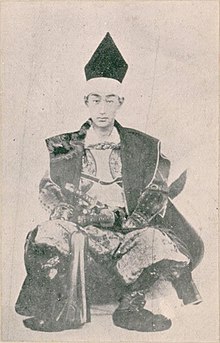
Back ماتسودايرا كاتاموري Arabic ماتسودايرا كاتامورى ARZ Matsudaira Katamori German Matsudaira Katamori Spanish ماتسودایرا کاتاموری Persian Matsudaira Katamori French Matsudaira Katamori ID 松平容保 Japanese 마쓰다이라 가타모리 Korean Matsudaira Katamori Portuguese
Matsudaira Katamori | |
|---|---|
 Matsudaira Katamori as Kyoto Shugoshoku | |
| In office 1852–1868 | |
| Preceded by | Matsudaira Katataka |
| Succeeded by | Matsudaira Nobunori |
| 9th Daimyō of Aizu Domain | |
| Monarchs | Shōgun |
| Kyoto Shugoshoku | |
| In office 1863–1864 | |
| Preceded by | None |
| Succeeded by | Matsudaira Yoshinaga |
| In office 1864–1867 | |
| Preceded by | Matsudaira Yoshinaga |
| Succeeded by | None |
| Personal details | |
| Born | February 15, 1836 Edo, Japan |
| Died | December 5, 1893 (aged 57) |
| Spouses | |

Matsudaira Katamori (松平 容保, February 15, 1836 – December 5, 1893) was a samurai who lived in Bakumatsu period and the early to mid Meiji period Japan. He was the 9th daimyō of the Aizu Domain and the Kyoto Shugoshoku (Military Commissioner of Kyoto). He initiated and established the Shinsengumi in 1863 (initially named Mibu Roshigumi).[1] During the Boshin War, he led Aizu Domain against the incipient Meiji government, but was severely defeated at the Battle of Aizu. Katamori's life was spared, and he later became the head kannushi of the Nikkō Tōshō-gū shrine. He, along with his three brothers Matsudaira Sadaaki, Tokugawa Yoshikatsu, and Tokugawa Mochiharu, had highly influential roles during the Meiji restoration and were called the "four Takasu brothers" (Takasu yon-kyōdai 高須四兄弟).
- ^ Stephane Lun (2021) "A Guide on Shinsengumi: the background and management." [Kindle paperwhite version] Retrieved from amazon.com
© MMXXIII Rich X Search. We shall prevail. All rights reserved. Rich X Search